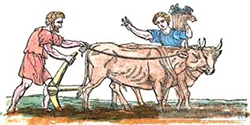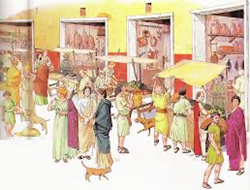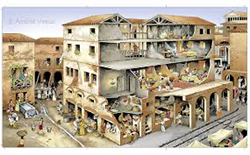Daily Life in Ancient Rome
The daily life of people in Roman times differed considerably based on a number of factors, including where people lived, who lived with them, and how much money they all had. 
A great many people lived in rural areas, on farms or in small dwellings in the countryside. Agriculture was a way of life for a great many people, and their daily lives were built around the needs of the harvest for whatever they were growing (in terms of food or foodstuffs) or husbanding (in terms of animals). Some people worked their own farmland. Many others worked on land owned by others. The latifundium, a large rural estate owned by someone who could afford to do so, was common from the earliest times of the Roman Republic; on such an estate worked mostly slaves, whose lives and livelihood were quite literally in the hands of the estate's owner(s). 
In cities and towns, workers, whether free or enslaved, toiled in various jobs. It was entirely common for teachers, architects, and even doctors to be slaves because slavery in Ancient Rome was quite different from slavery or serfdom in more modern times. Bakers, carpenters, engineers, jewelers, lawyers, potters, and other tradesmen were mostly free people who had to work for a living. Rich people who could afford not to work spent their days very differently. In general, the Romans worked from dawn until midday. Some shops reopened in early evening, but afternoons were mostly for leisure, such as going to the theater or the baths or to public festivals or games. Many public events had no admission cost, so poor people could attend without having to choose between entertainment and daily food and drink. From the days of the Empire, people of all income levels could enjoy baths as well (although people of various social classes tended to congregate accordingly and, certainly, slaves were still doing the work needed to provide the services that such baths offered). Temples as well often required nothing but time. Those who did work in Roman times had no regular days off. They did not have to work on days of public festivals or celebrations, which in some years were abundant. The Roman government was an employment opportunity for many people. Members of the Senate were generally rich landowners because for many years Senators were not paid and only those who could afford not to work would be free to serve in such a capacity. The government needed clerks, tax collectors, and other administrators, so that was an opportunity for many people to find some sort of stable employment. 
Children and younger adults who could afford it went to school, learning whatever their teachers knew to teach them. Common subjects were Latin, mathematics, philosophy, and rhetoric. Other subjects included Greek and sometimes science. Most schools had only boys. Some girls whose families were rich learned at home from private tutors. Most people in Roman times would eat two or three meals a day, generally at home if they could. The foods they eat and the beverages they drank varied depended on how much they could afford. In terms of living arrangements, it was not uncommon for a household to include several generations of a family. People who could afford their own homes or estates generally enjoyed the privilege of having space to move |
|
Social Studies for Kids
copyright 2002–2025
David White



 around within that home. Much more common was living in an insula, an apartment building. Some poor families crammed themselves into one room on a higher floor of an insula because they could afford nothing else. People who lived on these higher floors generally had no access to running water, which meant no access to a latrina (toilet). They could collect their waste and dump it in the street (a practice continued through the Middle Ages), or they could make use of public toilets, which were not abundant.
around within that home. Much more common was living in an insula, an apartment building. Some poor families crammed themselves into one room on a higher floor of an insula because they could afford nothing else. People who lived on these higher floors generally had no access to running water, which meant no access to a latrina (toilet). They could collect their waste and dump it in the street (a practice continued through the Middle Ages), or they could make use of public toilets, which were not abundant.
